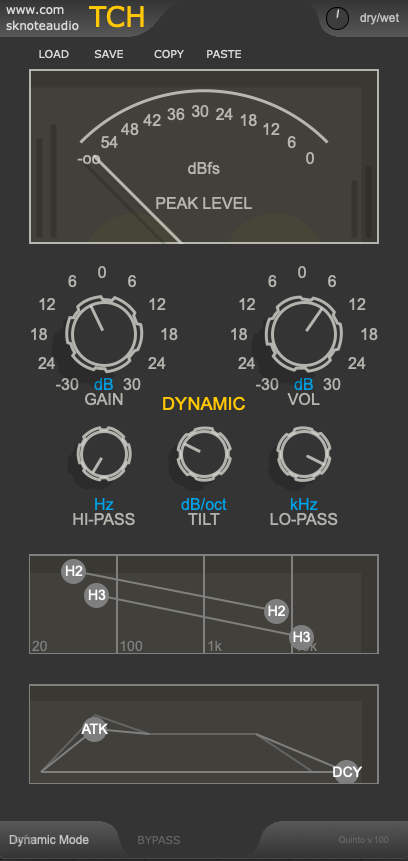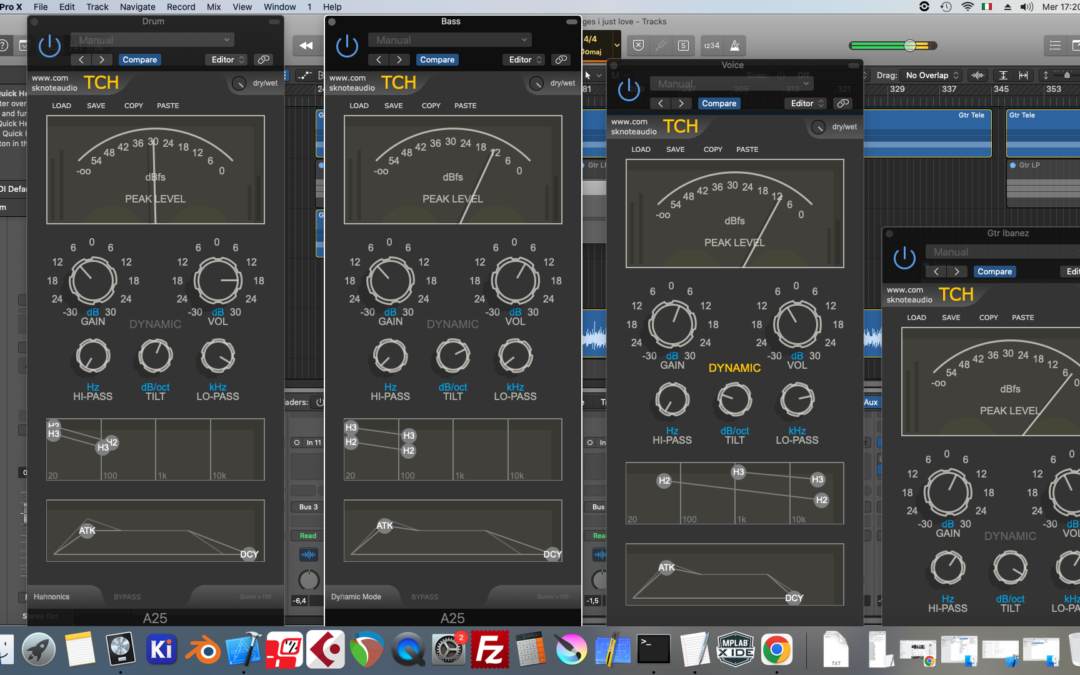It is a modern concept (no emulation) with direct control on a few basic parameters. Conceived to be used on tracks or groups in the mixer.
Features:
- High-pass filter.
- Tilt filter (with Dynamic option).
- Low-pass filter (with Dynamic option)
- Harmonics section with direct control on amount and frequency range for 2nd and 3rd harmonic.
- Envelope control (no thresholds). Tame or enhance the attacks, dry-out or extend the tails/ambience.
The Dynamic option engages the relevant mode for the Tilt and the Low-pass filters, making them more transparent and natural.
Insert one instance on each group and control the whole mix.
A simple Bypass-All button makes comparisons easy by disabling/enabling all the instances at once.
Coming as VST/AU/AAX-DSP for Windows and Mac OSX systems.
MSRP: 29.99$
You can currently test the Mac VST3/AU (native) BETA

TCH (Total CHannel), is simple but powerful.
The big meter shows the max level (from a mono channel or the max from a stereo channel). Is the reference for the saturation coming from the harmonics generator, when engaged.
An input Gain knob sets the internal working levels and a Volume knob compensates for it, to get a constant output level.
TCH includes three filters:
– A smooth (6dB/oct) high-pass filter. It is a bit special as it has a resonance peak that increases with the cutoff frequency.
A special, extremely handy Tilt filter makes balancing the brightness of the track super easy.
The low-pass filter has a smooth shape and covers the “harshness” range, up to 20kHz and beyond.
Tilt and low-pass filters can work in Dynamic mode (by engaging the Dynamic button). When in Dynamic mode, the processing can be a lot more transparent and natural.
TCH includes a special, super-simple Harmonic generator. It is engaged by clicking anywhere in an empty region of its area. Instead of emulating circuits, we have direct control on the amount of 2nd and 3rd harmonic added on top of the signal and how these levels change with frequency. Set the couple of handles for 2nd: their horizontal position describes the frequency range while the vertical position defines the level on that extreme. Same for the 3rd harmonic.
The other unique feature is the Envelope control. No thresholds: just define the amount of attack and release the signal should have. Remove ambient, stretch tails, tame peaks.
An super-useful touch is the “bypass-all” button, that bypasses all the instances in the project at once, to check how they are affecting the mix.
Technical notes.
In Dynamic mode, filter’s parameters (for Tilt and Low-pass) are controlled by the transients in the processed signal.
There are no thresholds, the system works with the shape of the envelope.
You can think of the Low-pass in Dynamic mode as darker on attacks.
You can think of the Tilt filter, in Dynamic mode, as affecting more the decay/sustain, less the attack.
Being threshold-less, the filters, even in Dynamic mode, are not affected by levels (input level, input gain).
Hi-pass is always static. Its shape changes with frequency setting, though. The higher the frequency setting, the steeper and more resonant the curve.
The harmonics are 100% affected by levels (input level, gain). They are discrete, single harmonics so just their levels are affected, there isn’t any spreading (there are not 4th, 6th…, 5th, 7th…, raising with increasing gain).
The envelope has no thresholds, so it is not affected by levels/gain.
The sequence is: gain, envelope, harmonics, filters, volume.
Filters are controlled by the signal PRE envelope control (when in Dynamic mode). So, for example, if you remove some attack by the Envelope control, this setting doesn’t change how filters react to the original attack.
